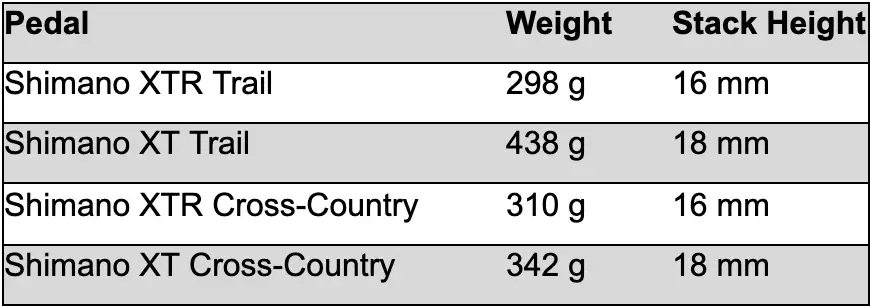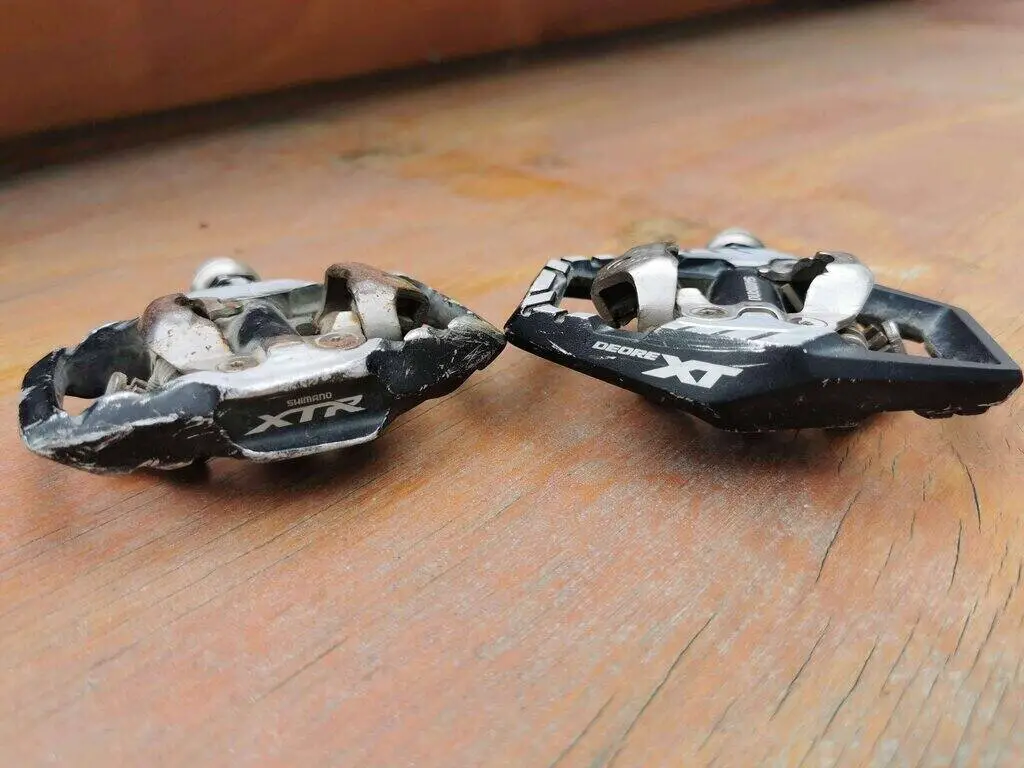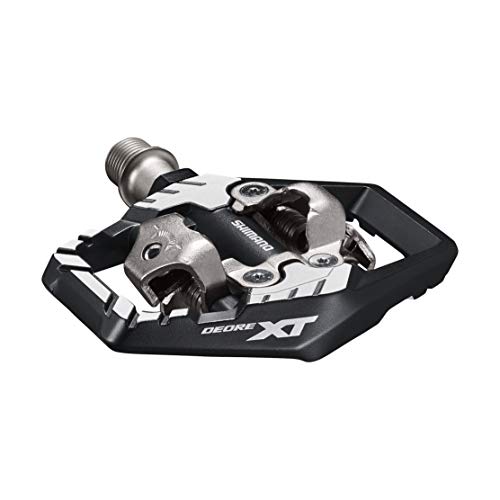Shimanos XT range has been my go-to set of pedals for the past few years, and I still haven’t come across a pair of pedals that I would prefer. I have used both the trail and cross-country pedals, but I predominantly ride enduro so have used those a lot more.
They are both awesome pedals, and I have just set and forget about them with no issues popping up at all, and they take a hammering!
Anyway, let’s dive into the details of these pedals, I have made this comprehensive so use the Table of Contents to navigate to the piece of content that you are after.
What Is The Difference Between The XT and XTR Pedals?
First of all, what is the difference between the XT and XTR, and why do these different pedals exist?
Essentially they are both higher-end pedals from Shimano that both have some great features, but the XTR is a slightly better version than the XT. The XTR is the race model of the XT and so is more optimized for racing either cross-country or enduro depending on the type that you choose.
The XT and XTRs are built on a similar platform, but the axle of the XTRs is optimized for weight and slimness where the XT is not. This results in superior mud-shedding abilities.
The XTR model is also lighter than the XT due to slightly less and better quality materials used. See each of the specific pedal comparisons below for the details.

Finally, the final significant difference between them is the stack height of the pedals. This is the thickness of the pedal and is important as it affects the dynamics of your pedaling.
The stack on a pedal effectively increases the crank length of the bike by half the stack height as the pedals are thicker. Moreover, this means that your pedal rotation becomes more non-circular the greater the stack height. When the cranks are at 12 and 6 the stack is making the largest difference to the crank length. However, when the pedals are at 3 and 9, the stack isn’t making any difference. This results in a non-circular pedal motion.
Most riders won’t notice the difference, but it’s worth considering whether that is a factor that you should consider.
Well there it is, the XTR is effectively a slightly better version of the XT, but that does come at a slightly higher price point.
Shimano XT Vs XTR Trail Pedals Comparison
This pedal is renowned for its excellent durability and is the sweet spot in Shimanos Enduro pedal line up. A great pedal for all-round mountain biking and personally the pedal I use the most.
Shimanos enduro race pedal that would suit those who love trail riding out in the big gnarly terrain.
Now we have established an overview of what each of the pedals offer. Let’s dive deeper into the specific pedals that Shimano offers.
First is the trail pedal comparison, they are pretty much the same as the cross-country pedals with a platform attached. The platform adds extra stability for the foot and also protects the clip mechanism from rock strikes.
Weight
Let’s get straight to the most considerable difference between them. That is the weight of the pedals. The XTR trail pedal is the lightest of the two weighing in at 398 g as compared to the XT at 438 g.
A weight difference of 40 g is the result, although this may not seem significant, it is weight that must be moved up and down, and so it will have more of a difference than you think.
Mud-Shedding
The next big difference is the mud-shedding abilities, the XTR has a much slimmer through-axle and is, therefore, less prone to a build-up of mud on the pedals. Depending on where you ride and how muddy it is will determine how important this factor is for you.
Stack Height
Again the stack height of the XTR is 16 mm compared to the XT, which is 18 mm. It may not sound like a lot, but an experienced rider will pick up on that.
First of all, a larger stack height will increase your chances of rock strikes and clipping your pedals on anything while out shredding the trails.
Also, a larger stack effects your pedal stroke more by essentially increasing the length of your crank by half the stack height. This occurs most at 12 and 6, but not at all at 9 and 3. Therefore, it leads to a non-circular pedal stroke. It may make your pedalling not be as smooth as with a lower stack pedal.
Platform
The platform on both of them is pretty much the same, both are very similar designs and you won’t notice much of a difference between them.
Durability
Both the XT and XTR are renowned for their incredible build quality and are set-and-forget pedals. There is a huge amount of protection between the outside world and the internal bearings of the pedal. The result is that mud and dust will really struggle to get into the bearings, and so they require very little servicing.
The XTRs have an axle optimized for weight and slimness, which there could be an argument made that it would mean they wouldn’t last as long as the XTs. In my opinion, and what others have experienced, this is by no means the case. Both are great pedals that will keep spinning.
Conclusion
So which one should you get? Well, you won’t be disappointed with either, ultimately it will come down to your budget. I have used both of these pedals for many years and can say that either way, you are getting a great pedal.
However, there are several nice to have features on the XTR that arent on the XT, the weight alone is a nice benefit. Therefore, if you can stretch the budget for the XTR, I believe that is the way to go.
Shimanos enduro race pedal that would suit those who love trail riding out in the big gnarly terrain.
This pedal is renowned for its excellent durability and is the sweet spot in Shimanos Enduro pedal line up. A great pedal for all-round mountain biking and personally the pedal I use the most.
Shimano XT Vs XTR Cross Country Pedals Comparison
The main differences between the XT and XTR cross-country pedals are essentially the same as the trail pedals. The main difference between them is the weight, so we will start there.
Weight
Again the XTRs are lighter weighing in at 310 g whereas the XT weighs in at 342 g. That’s a difference of 28 g which will make a difference if you are really into your cross-country racing.
The difference originates from the fact that the XTR is a more weight-optimized design to keep the pedal light. The trade-off is a slightly higher weight.
Mud-Shedding
Since the pedals axle is the same as the trail, the slimmer axle housing found in the XTR models will provide better mud and debris shedding abilities.
The larger axle housing found on the XT results in more mud and debris being trapped within the pedal cleat system which can prevent you from clipping in if it builds up to much.
Stack Height
Since the mechanism and axle of both the trail pedals and xc pedals are the same, the stack will also be the same. I have included the difference below just in case you missed it in the trail pedal comparison.
Again the stack height of the XTR is 16 mm compared to the XT, which is 18 mm. It may not sound like a lot, but it will certainly make a difference.
Durability
Again they are still the Shimano XT range and so they are renowned for their reliability and durability. There is something to be said that the slimmer weight-optimized axle found on the XTRs won’t be as durable as the thicker and heavier XT. However, in my experience, they have both been incredibly durable, and I haven’t had any issues over the years using these pedals.
Conclusion
Again my overall verdict would have to be the same as for the trail pedals. If your budget allows, the XTRs have some nice to have features and will give a smoother pedal stroke which will be appreciated on those long rides.
Also if you are really into your cross country or even gravel bike racing, then the XTR is definitely the one to go for. The XTR will allow you to squeeze out those little advantages over your competition.
The ultimate Shimano cross-country mountain bike race pedal. Best suited for those that like to ride the undulating cross-country trails or even for the gavel bike.
A step down from the XTR but still a bulletproof pedal, great for the weekend warrior.
Cross-Country or Trail Range?
Ultimately there are a few factors that will decide whether the cross-country range or the trail range will be best for you.
First off is your style of riding, if you stick to the undulating trails and are not out there for shredding the downhills then the cross-country range will be better for you.
That being said, if you are a beginner, then you may be better off with the trail range. The platform will allow you a place to put your foot if you don’t clip-in in time, or just don’t feel comfortable clipping in.
On the other hand, if you go out riding mainly for the downhills and don’t mind the extra weight that the platform adds then the trail shoes are likely for you. The platform provides additional support which is great for when the trail gets rough!
Still a bit confused about the different kind of mountain bike pedals? Check out our guide here.
Conclusion
So that’s everything you need to know about the difference between the XTs and XTRs. The XTRs are essentially the race version of the XT. They are more refined for racing and the qualities you would look for in a pedal.
Therefore if you are looking at racing cross-country or enduro, then you should go for the XTR model.
There are a number of features on the XTR which will benefit every rider, and for the price difference, it is worth having. So if your budget allows then going for the XTR will certainly be an excellent option.




